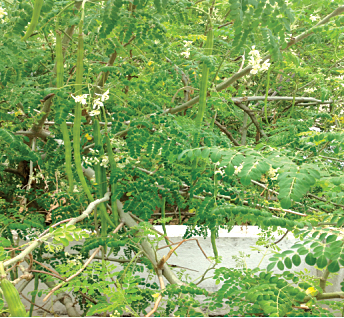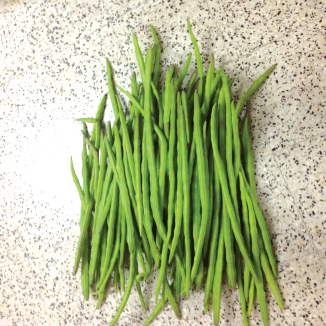Registered with the Registrar of Newspapers for India under R.N.I 53640/91
Vol. XXVII No. 23, March 16-31, 2018
The eco-tree par excellence
by Dr. P.J. Sanjeeva Raj rajsanjeeva@gmail.com

“Moringa in my garden” – Dr. Sanjeeva Raj
An eco-tree is one that offers both ecological as well as survival benefits to humans. The Drumstick tree, popularly known today as the Moringa, has suddenly shot into global fame, as a ‘miracle tree’. Moringa oleifera is a tropical and sub-tropical multipurpose tree, because every part of this tree has amazing ecological, nutritional, medicinal, economic and research values for humans.
Ecologically, the leaves of Moringa purify air and water, and fertilise soil and crops. Moringa leaves, as ‘carbon-sinks’, incredibly absorb about 20 times more atmospheric carbon dioxide than most other trees, contributing substantially to carbon sequestration, to solve the great global threat of ‘climate change’. Powder or decoction of Moringa leaves or seeds, fresh or dried, clarify and purify turbid and polluted water, sedimenting suspended particles, absorbing dissolved obnoxious salts and even killing bacteria. Moringa leaves, with an unusually high per cent of proteins and nitrogen among plants, and with rich content of minerals, including NPK, fertilise degraded soils and lands, and the leaf decoction sprayed, fertilise withering plants and crops, as a whole. However, considering the volume of Moringa leaves used for food and commerce in the tropics, developing vast Moringa farms may compensate.

Nutritionally, Moringa is called in the developing countries as a ‘super food’ or even as an ‘elixir of life’. Moringa leaves, quite unusual from other leaves, contain nearly ten per cent of their wet weight, by proteins, made up unbelievably of 17 out of the 20 amino acids known. In addition, these leaves contain vitamins, several times more than in other vegetables, vitamins like A, B-complex, C, D and E. As in a ‘power house of minerals’, nearly eight different minerals, in large quantities are loaded into Moringa leaves and pods. The calorific value of Moringa leaves is more than in its pods, and all these promote the production of breast milk, so that it could solve the great malnutrition problem prevalent among babies in poor developing countries.
The white kernel of the Moringa seed contains 40 per cent of its wet weight as an oil, called Ben oil, a natural biodiesel, used also as an ingredient in cosmetics. More interestingly the Moringa seeds are a store-house of energy, as in the famous Arogya Pacha (Trichopus zeylanicus) of the Kani tribals in Kerala, who go without food for two or three days in the forest, surviving by feeding merely on the seeds of Arogya Pacha, now patented as “Jeevani”.
Medicinally, since ancient times, in the rural tropics, the poor have been using Moringa as a cure for a wide variety of health ailments, so Moringa has been reckoned as a ‘medicine chest’ or as a ‘doctor at home’. The unique combination of a wide variety of rich nutrients in Moringa is the chief reason for its capacity to heal diverse ailments. However, overdosage or ignorant use of some Moringa parts cannot be encouraged. Also clinical research and confirmation of Moringa therapeutics is a lacuna in our present enthusiasm for Moringa cures.
Economically, apart from providing such ambrosia-like food and elixir-like medicines, Moringa can fetch a livelihood income for the poor, as well as profitable exports for the rich. Sale and export of green or powdered dried leaves, seeds and pods green or their pulp frozen, seed oil, all in packages have great export potential targeting markets in the temperate and affluent countries.
Research, in cultivating Moringa and research on its nutritional and medicinal values, is being pursued actively all over the world. However, clinical research on its medicinal values needs to be pursued more.
Abandoned drylands, open spaces in residential areas and public compounds in the tropical countries could be deployed for Moringa farming which would provide not only all these benefits but also livelihoods for the poor, through this ‘Tree of the Future’, as the world calls it today. In propagating Moringa trees, better than through seeds, cuttings in situ (on the tree itself) rather than ex situ (on the ground) is preferable. The 70 to 80 insect pests on Moringa, including the hairy caterpillars, the most detestable ones, are all controllable, today.
Trees are said to be the angels of God, providing all human needs on Earth. Moringa certainly is God’s special gift for the poor of the developing countries.

